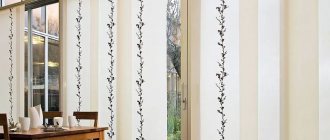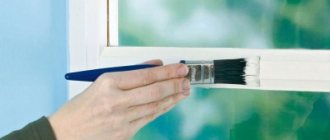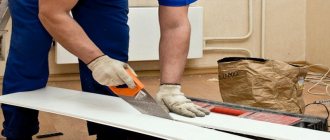Thanks to modern technologies, it is now possible to obtain glass products of various shapes and complexity. The glass is given a shaped edge, sharp edges are removed, glued, holes of different diameters are drilled, and other operations are performed to give the fragile material strength and at the same time grace. All processes require special high-precision equipment and tools.
What are the glass processing technologies?
When processing glass products, the following technologies are used:
- Beveling or chamfering. This is a mechanical process in which the edge of a mirror or sheet glass is removed at an angle in a decorative manner. It can be compared to cutting gemstones, and how the appearance of the piece is transformed depends on the angle of the edge. The bevel can be double (additional cutting on the cut edge), rectilinear (straight bevel), one-sided (the canvas is processed on only one side), double-sided (two sides of the blade are processed), curved (a shaped design is performed).
- Chamfering, polishing, grinding. This is a dulling of the edges of the glass sheet, necessary to give an aesthetic appearance to the product, relieve stress in the edge, and increase safety during operation of the product.
- Slicing. Shape cutting technology is used for cutting sheet glass and mirrors with subsequent mechanical processing. The material is cut with a liquid-abrasive jet (hydro-method) or with a cutting head if a standard cutting is required. Advantages of the method: speed, absence of heating and deformation, low noise process, no fine-grained waste.
- Drilling, milling, countersinking. This is drilling and processing holes in glass sheet. Operations require high precision, since the slightest violation of technology can lead to the formation of hidden cracks, chips, and destruction of the material.
- Matting. Decorative matte elements are applied to mirrors using sandblasting machines. By adjusting the pressure, you can create matting of varying intensity: from deep relief patterns to a silky matte surface.
- Bending. This is a technology for bending glass after heating it to 600–650 °C. The material softens and can be shaped into various shapes. In the process, quality characteristics are not affected, whether transparent or tinted products.
- Hardening. This is a heat treatment in which glass is heated to 600 °C and cooled sharply. This increases the mechanical strength of the material and its safety even in the event of complete destruction: the fragments are obtained with blunt edges. Tempered glass can withstand temperature changes from -70 to +250 °C, therefore it is often used for the manufacture of tableware and container glass.
- Triplexing. This gluing of 2-3 panels using a polymer film, which holds fragments when glass breaks, increases sound insulation. Triplex is used in industry, the furniture industry, for glass in interior doors and partitions, for automobile glass, including armored glass, for windows in trains, for windows in airplanes and spaceships.
- Silkscreen or screen printing. This is the application of images on glass or mirrors by baking ceramic paints. The designs are resistant to moisture and sunlight.
- Ultraviolet printing. A type of inkjet printing using ink that hardens under the influence of ultraviolet light, forming a film on the surface.
- Chemical etching. The technology is used for frosting glass. Due to the complexity and high cost of the process, it is used for decorating designer glass products.
Glass cutting techniques
In industry and production, an automated method of such processing is used. Machines can be different - for example, equipment with mechanical cutting heads is traditionally used. A rather promising direction is waterjet cutting of glass, which is characterized by high accuracy and the absence of negative side effects. The operator of such a machine can carefully and very finely perform processing, regardless of the complexity of the cutting line. In this case, the direct working element for cutting is a water jet, supplemented with sand abrasive particles.
The waterjet method was preceded by sandblasting. In essence, the principle of operation is the same, but air is used instead of a liquid medium. As for the quality of the result, cutting glass with a sandblaster is inferior to waterjet. But this method turns out to be more economical due to the absence of the need to supply a water resource.
Equipment and tools for glass processing
Equipment for working with glass is freely available, but it is better if this process is handled by professionals, since the material is fragile and requires caution and safety precautions.
To work with glass, depending on the type of operation, certain machines are used:
- Edge processing machines. There are horizontal, vertical and shaped edge processing, as well as lines for the production of auto glass.
- Tables for straight and curved cutting of fabrics. The machines perform straight and figured cutting. Depending on the modification and equipment, they can handle a strictly defined glass thickness. The equipment is automated and is used for the manufacture of double-glazed windows and furniture.
- Glass drilling machine. Double-sided processing is performed, which allows you to drill a hole of any diameter without chips or microcracks. The equipment is used both in large industries and in small glass workshops.
- Bevel machine. The machines perform beveling without templates with products of any shape. Along the entire contour, the bevel is of the same width. The equipment is used in production workshops.
- Sandblasting installation. The devices perform sandblasting matting or applying patterns by supplying abrasive particles with a jet of compressed air.
- Furnaces for bending and fusing. The machines are designed for the production of decorative interior products.
Photo of the bending oven:
In addition to the above equipment, tempering furnaces, machines for waterjet cutting, triplexing, and lifts are used in glassmaking. Among the tools used in workshops are drills and cutters, grinding bowls and wheels, glass cutters, sandblasting guns, countersinks, etc.
Tempering glass
The tempering process is aimed at increasing the strength characteristics of glass. The basic equipment is a furnace that operates at temperatures of about 6000 °C. When heated, the conveyor rollers move the workpieces, protecting individual edges from overheating. The next stage of hardening involves a cooling effect. Thermal treatment of glass creates mechanical compression forces on its surface, which helps to increase the strength of the material several times. As technologists note, hardening also gives products increased heat resistance and tolerance to strong vibration loads. It is worth noting that glass should be subjected to direct mechanical processing before the tempering process, since after it it will no longer be possible to do this.
Glass decoration - areas of application
Decorating glass has become one of the means to achieve an aesthetic appearance of a building both inside and outside. Currently, thanks to various glass processing technologies, it has become possible to decorate it in a variety of ways. Such glass can be used in window structures, for glazing doorways, partitions, glass showers, stairs, floors and ceilings, kitchen splashbacks and so on. Original artistic decorative effects on glass can give the interior the missing zest.
With the development and improvement of glass manufacturing technologies and an increase in its technical characteristics, it has become possible to create a wide variety of patterns on glass - everything that the imagination of the designer or customer can do.
Photo: Decorative glass as an insert on the ceiling
Tinting with armor and color films
Glass is reinforced by gluing a durable polymer film onto it. This technology makes the material resistant to impact and safe to break. The fragments formed upon impact do not fly apart and you cannot cut yourself on them. Film tinting is used to reduce translucency and decorate glass. The material processed in this way is used in cars, facades and windows of buildings, roofing structures, etc. Thanks to the use of films of various colors, glass of any shade can be produced.
Triplexing
This operation involves gluing several glasses or mirrors into a single multilayer sheet using transparent glue. Triplex is used in internal and external glazing of buildings, in the construction of roofing structures and facades. Using a colored translucent film placed between layers of glass, you can give the canvas different shades, increase or decrease its light transmittance.
Make an order
Fill out the fields below and our manager will call you back as soon as possible
Application for installation
Fill out the fields below and our manager will call you back as soon as possible
Cutouts in glass
Specialists make cuts in the glass. In each case, the type of cutouts is agreed upon individually when placing an order. The processing of the glass edge on the inner sides of the cutouts is carried out by grinding.
Glass cutout service >>>
| Services list | Price | Note |
| Loop hole | Prices for services | DORMA, etc. |
Ultraviolet gluing
Bonding and soldering technologies stem from the need to solve a common problem in the electronics industry. The fact is that combining metal and glass into a single piece previously did not provide sufficient gas-tight resistance. The solution to the problem was the emergence of new methods that make it possible to implement better soldering. One of the most popular methods is gluing using special compounds. In addition to applying the adhesive, the glass is also supposed to be treated with ultraviolet radiation. During the polymerization process, the connection acquires sufficient strength and a wide range of other protective properties, not to mention the tightness of the bond.
Chemical etching
The purpose of using this technique is also to ensure a matte finish on the glass surface. Only, unlike the previous method, not a sandblasting tool is used, but a chemical effect. Special molds ensure contact between glass and acidic vapors, which result in the formation of insoluble salts. It must be said that the types of glass processing by etching are quite diverse precisely because of the use of a wide group of chemical reagents. In this case, not only the directly active elements are noted, but also the substances that cover areas not intended for treatment. This is especially true for artistic processing operations. Another important difference between chemical treatment and sandblasting is the passage of hardening after contact with acidic environments.











